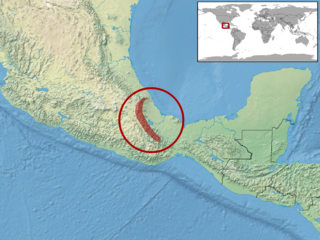
Celestus is a genus of diploglossid lizards mostly endemic to Jamaica and containing about 11 species, though three of these may be extinct. They are commonly known as galliwasps although the origin of this name is unclear. Formerly, this genus had more than 31 species, but a 2021 phylogenetic study found this classification to be paraphyletic and split those species into their own genera. A more recent study found that several ecomorphs exist on Jamaica including a swamp ecomorph, a tree ecomorph, and a ground ecomorph.

Diploglossidae is a family of anguimorph lizards native to the Americas, with most genera being endemic to Hispaniola. Most members of this family are known as galliwasps. They were formerly considered a subfamily of Anguidae, but genetic evidence has shown them to be less closely related to other members of Anguidae than Anniellidae is.

Panolopus marcanoi, commonly known as Marcano's galliwasp or Pico Duarte galliwasp, is a species of lizard in the family Diploglossidae. It is endemic to the Dominican Republic.
Celestus barbouri, also known commonly as Barbour's galliwasp and the limestone forest galliwasp, is a species of lizard in the family Diploglossidae. The species is endemic to Jamaica.
Panolopus curtissi, also known commonly as Curtiss' galliwasp, Curtis's galliwasp, and the Hispaniolan khaki galliwasp, is a species of lizard in the family Diploglossidae endemic to the island of Hispaniola and surrounding islets.
Caribicus darlingtoni, also known commonly as Darlington's galliwasp and the Hispaniolan striped galliwasp, is a species of lizard in the family Diploglossidae. The species is endemic to the Dominican Republic on the Caribbean island of Hispaniola.

Siderolamprus enneagrammus, the Huaxteca lesser galliwasp, is a species of lizard of the Diploglossidae family. It is found in Mexico.

Siderolamprus ingridae, Ingrid’s galliwasp, is a species of lizard of the Diploglossidae family. It is found in Mexico.
Siderolamprus legnotus, Campbell's galliwasp, is a species of lizard of the Diploglossidae family. It is found in Mexico.

Comptus stenurus, the Hispaniolan keeled galliwasp or Cope's galliwasp, is a species of lizard of the Diploglossidae family endemic to the Caribbean island of Hispaniola.
Siderolamprus atitlanensis, the Atitlán galliwasp, is a species of lizard of the Diploglossidae family. It is found in Mexico, Guatemala, and El Salvador.

Mesoamericus bilobatus, also known commonly as O'Shaughnessy's galliwasp, is a species of lizard in the family Diploglossidae. The species is native to Central America.
Siderolamprus bivittatus, the two-banded galliwasp, is a species of lizard of the Diploglossidae family. It is found in Guatemala, Honduras, El Salvador, and Nicaragua.
Siderolamprus montanus, the mountain lesser galliwasp, is a species of lizard of the Diploglossidae family. It is found in Honduras.
Advenus montisilvestris, also known commonly as the mountain forest galliwasp, is a species of lizard in the family Diploglossidae. The species is endemic to Panama. It is the only member of the genus Advenus, and it as the only species of the subfamily Celestinae that is found outside of the Caribbean.
Siderolamprus owenii, Owen's galliwasp, is a species of lizard of the Diploglossidae family. It is found in Mexico and Guatemala. It was named after British biologist and paleontologist Richard Owen.

Comptus is a genus of diploglossid lizards native to the West Indies.

Panolopus is a genus of diploglossid lizards endemic to the island of Hispaniola in the Caribbean, in both the Dominican Republic and Haiti.
Wetmorena is a genus of diploglossid lizards endemic to the island of Hispaniola in the Caribbean, occurring in both the Dominican Republic and Haiti.

Siderolamprus is a genus of lizards in the family Diploglossidae. Member species are found throughout much of Central America. They are considered the only members of the subfamily Siderolamprinae, although Diploglossus bilobatus is sometimes reclassified into the monotypic genus Mesoamericus and placed with them.






